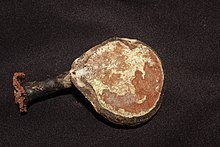Ganoderma orbiforme: Difference between revisions
Content deleted Content added
→References: New section ==External links== with CABI and IUCN Red. |
Hemibiotrophy from Bahari et al 2018. |
||
| Line 22: | Line 22: | ||
'''''Ganoderma orbiforme''''' is a species of [[polypore]] fungus that is widespread across southeast Asia. It is a [[plant pathogen]] that causes '''basal stem rot''', a disease of the [[African oil palm]] (''Elaeis guineensis''). The fungus was first [[species description|described]] scientifically in 1838 by [[Elias Magnus Fries]] from collections made in [[Guinea]].<ref name="Fries 1838"/> [[Leif Ryvarden]] transferred it to the genus ''[[Ganoderma]]'' in 2000. In addition to its [[type locality (biology)|type locality]], the fungus has also been collected from the [[Bonin Islands]] in the Pacific, and from Venezuela and Puerto Rico.<ref name="Ryvarden 2000"/> [[Microsatellite]] markers have been developed to help identify the fungus and study the [[genetic diversity]] of ''G. orbiforme''.<ref name="Mercière 2015"/> |
'''''Ganoderma orbiforme''''' is a species of [[polypore]] fungus that is widespread across southeast Asia. It is a [[plant pathogen]] that causes '''basal stem rot''', a disease of the [[African oil palm]] (''Elaeis guineensis''). The fungus was first [[species description|described]] scientifically in 1838 by [[Elias Magnus Fries]] from collections made in [[Guinea]].<ref name="Fries 1838"/> [[Leif Ryvarden]] transferred it to the genus ''[[Ganoderma]]'' in 2000. In addition to its [[type locality (biology)|type locality]], the fungus has also been collected from the [[Bonin Islands]] in the Pacific, and from Venezuela and Puerto Rico.<ref name="Ryvarden 2000"/> [[Microsatellite]] markers have been developed to help identify the fungus and study the [[genetic diversity]] of ''G. orbiforme''.<ref name="Mercière 2015"/> |
||
''G. orbiforme'' has a [[Hemibiotrophs|hemibiotrophic]] lifestyle in ''E. guineensis''.<ref name="Bahari-et-al-2018" /> |
|||
==References== |
==References== |
||
| Line 32: | Line 34: | ||
<ref name="Ryvarden 2000">{{cite journal |author=Ryvarden, Leif |year=2000 |title=Studies in neotropical polypores 2: a preliminary key to neotropical species of ''Ganoderma'' with a laccate pileus |journal=Mycologia |volume=92 |issue=1 |pages=180–191 |jstor=3761462 |doi=10.2307/3761462}}</ref> |
<ref name="Ryvarden 2000">{{cite journal |author=Ryvarden, Leif |year=2000 |title=Studies in neotropical polypores 2: a preliminary key to neotropical species of ''Ganoderma'' with a laccate pileus |journal=Mycologia |volume=92 |issue=1 |pages=180–191 |jstor=3761462 |doi=10.2307/3761462}}</ref> |
||
<ref name="Bahari-et-al-2018">{{cite journal | last1=Bahari | first1=Mohammad Nazri Abdul | last2=Sakeh | first2=Nurshafika Mohd | last3=Abdullah | first3=Siti Nor Akmar | last4=Ramli | first4=Redzyque Ramza | last5=Kadkhodaei | first5=Saied | title=Transciptome profiling at early infection of ''Elaeis guineensis'' by ''Ganoderma boninense'' provides novel insights on fungal transition from biotrophic to necrotrophic phase | journal=[[BMC Plant Biology]] | publisher=[[Springer Science+Business Media|Springer Science and Business Media LLC]] | volume=18 | issue=1 | year=2018 | issn=1471-2229 | doi=10.1186/s12870-018-1594-9 | page=}}</ref> |
|||
}} |
}} |
||
Revision as of 21:28, 1 January 2021
| Ganoderma orbiforme | |
|---|---|

| |
| Scientific classification | |
| Kingdom: | |
| Division: | |
| Class: | |
| Order: | |
| Family: | |
| Genus: | |
| Species: | G. orbiforme
|
| Binomial name | |
| Ganoderma orbiforme | |
| Synonyms | |
| |
Ganoderma orbiforme is a species of polypore fungus that is widespread across southeast Asia. It is a plant pathogen that causes basal stem rot, a disease of the African oil palm (Elaeis guineensis). The fungus was first described scientifically in 1838 by Elias Magnus Fries from collections made in Guinea.[1] Leif Ryvarden transferred it to the genus Ganoderma in 2000. In addition to its type locality, the fungus has also been collected from the Bonin Islands in the Pacific, and from Venezuela and Puerto Rico.[2] Microsatellite markers have been developed to help identify the fungus and study the genetic diversity of G. orbiforme.[3]
G. orbiforme has a hemibiotrophic lifestyle in E. guineensis.[4]
References
- ^ Fries, E.M. (1838). Epicrisis Systematis Mycologici (in Latin). Uppsala: Typ. Acad. p. 463.
- ^ Ryvarden, Leif (2000). "Studies in neotropical polypores 2: a preliminary key to neotropical species of Ganoderma with a laccate pileus". Mycologia. 92 (1): 180–191. doi:10.2307/3761462. JSTOR 3761462.
- ^ Mercière, Maxime; Laybats, Anthony; Carasco-Lacombe, Catherine; Tan, Joon Sheong; Klopp, Christophe; Durand-Gasselin, Tristan; Alwee, Sharifah Shahrul Rabiah Syed; Camus-Kulandaivelu, Létizia; Breton, Fréderic (2015). "Identification and development of new polymorphic microsatellite markers using genome assembly for Ganoderma boninense, causal agent of oil palm basal stem rot disease". Mycological Progress. 14 (11): 103. doi:10.1007/s11557-015-1123-2.

- ^ Bahari, Mohammad Nazri Abdul; Sakeh, Nurshafika Mohd; Abdullah, Siti Nor Akmar; Ramli, Redzyque Ramza; Kadkhodaei, Saied (2018). "Transciptome profiling at early infection of Elaeis guineensis by Ganoderma boninense provides novel insights on fungal transition from biotrophic to necrotrophic phase". BMC Plant Biology. 18 (1). Springer Science and Business Media LLC. doi:10.1186/s12870-018-1594-9. ISSN 1471-2229.
{{cite journal}}: CS1 maint: unflagged free DOI (link)
External links
- "Ganoderma orbiforme". CABI. 2019-12-10. Retrieved 2020-11-12.
- "Ganoderma orbiforme". The Global Fungal Red List Initiative. 2020-06-30. Retrieved 2020-11-12.
